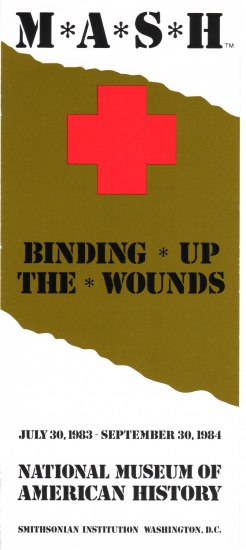When the series finale of M*A*S*H premiered on February 28, 1983, it became the most watched television broadcast in American history. It should have been of no surprise, then, that a M*A*S*H exhibit at the Smithsonian National Museum of American History would attract a flood of enthusiastic visitors.

Plans for the exhibit began with a few great minds thinking alike. Museum specialist Michael Harris had the idea to approach Twentieth Century Fox about donating objects from the hit show while on his upcoming vacation to California in 1982, and the curator in the Division of Community Life, Carl Sheele, was on board. The two hoped that the company might donate Hawkeye’s Hawaiian shirt or a few stethoscopes. Just as they were plotting their approach, Twentieth Century Fox beat them to the punch and reached out to the Smithsonian.
But what the company planned to donate was even better than expected.
Twentieth Century Fox offered props, costumes, scripts, and two complete sets, the Operating Room and the “Swamp.” This donation became the first of two occasions in which the museum accepted an entire set from a television production.

Harris made his final collecting trip just after filming wrapped in January 1983, and the artifacts arrived at the museum by May. M*A*S*H: Binding Up the Wounds, initially titled M*A*S*H: The Two Wars, was set to open to the general public on July 30, 1983 after a donation ceremony and panel the day before.
In attendance at the event were stars Alan Alda, Mike Farrell, and William Christopher, producer Gene Reynolds, and head of Twentieth Century Fox Worldwide syndication Robert Morin. Watch the group answer questions from the audience below.
During the program, museum director Roger Kennedy made a speech about the importance of the donation, the group shared what it meant for the show to be included at the Smithsonian, and Morin, Harris, and Scheele signed the formal deed of gift.
In one answer to an audience question during the Q&A portion of the event, Alda articulated what the donation to the Smithsonian meant to him in closing this chapter in his career. “It’s one of the things I was looking forward to today…in a way, it kind of emotionally puts a cap on it. It’s a terrific honor.”

Visitors flocked to the exhibit, and the museum soon implemented a timed pass system. Before the ticketing, however, some complained about the crowds. One disconcerted guest wrote directly to Secretary Ripley about how she would not renew her membership to the Smithsonian Resident Associate Program because her group waited in line for two hours, were only allowed ten minutes in the exhibit, and felt rushed by guards.
The pass system was evidently necessary, considering that by the time the exhibit closed in February 1985, after two extensions, 1,073,849 visits had taken place. In the month of July 1984, alone, the museum counted 84,113 visitors.
And the responses were overwhelmingly positive. One visitor from Virginia commented, “I’ve had about twenty visitors since your exhibit has been here-all of them say, ‘first we want to see the M*A*S*H exhibit.'” Other museums across the country, too, recognized the success of the show and lined up to be considered as locations for a potential traveling exhibit.
Anticipating the huge reception that the exhibit would receive, Washington Post journalist Roger Piantados predicted, "’M*A*S*H: Binding Up the Wounds' will make the Smithsonian Museum of American History so popular a tourist stop this summer that someone may be moved to create a TV sitcom about the place.”
We’d definitely watch that.
Related Resources
- “Looking Back on ‘M*A*S*H,’ the show and the exhibition,” by Lucy Harvey, O Say Can You See?, National Museum of American History
- “M*A*S*H ended, but is not gone or forgotten,” by Lucy Harvey, O Say Can You See?, National Museum of American History
- “Its TV series ended, M.A.S.H. draws crowds at the Smithsonian,” by Maggie Jackson, 13 August 1983, United Press International
- “MASH Lives, At the Smithsonian,” by Roger Piantados, 29 July 1983, Washington Post
Produced by the Smithsonian Institution Archives. For copyright questions, please see the Terms of Use.

Leave a Comment